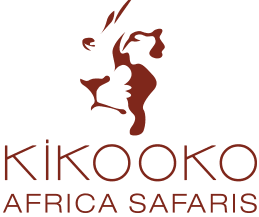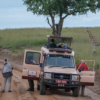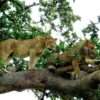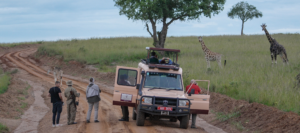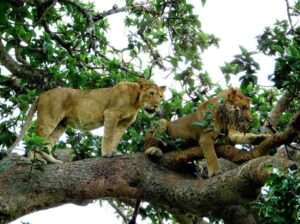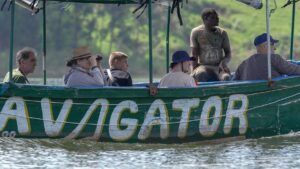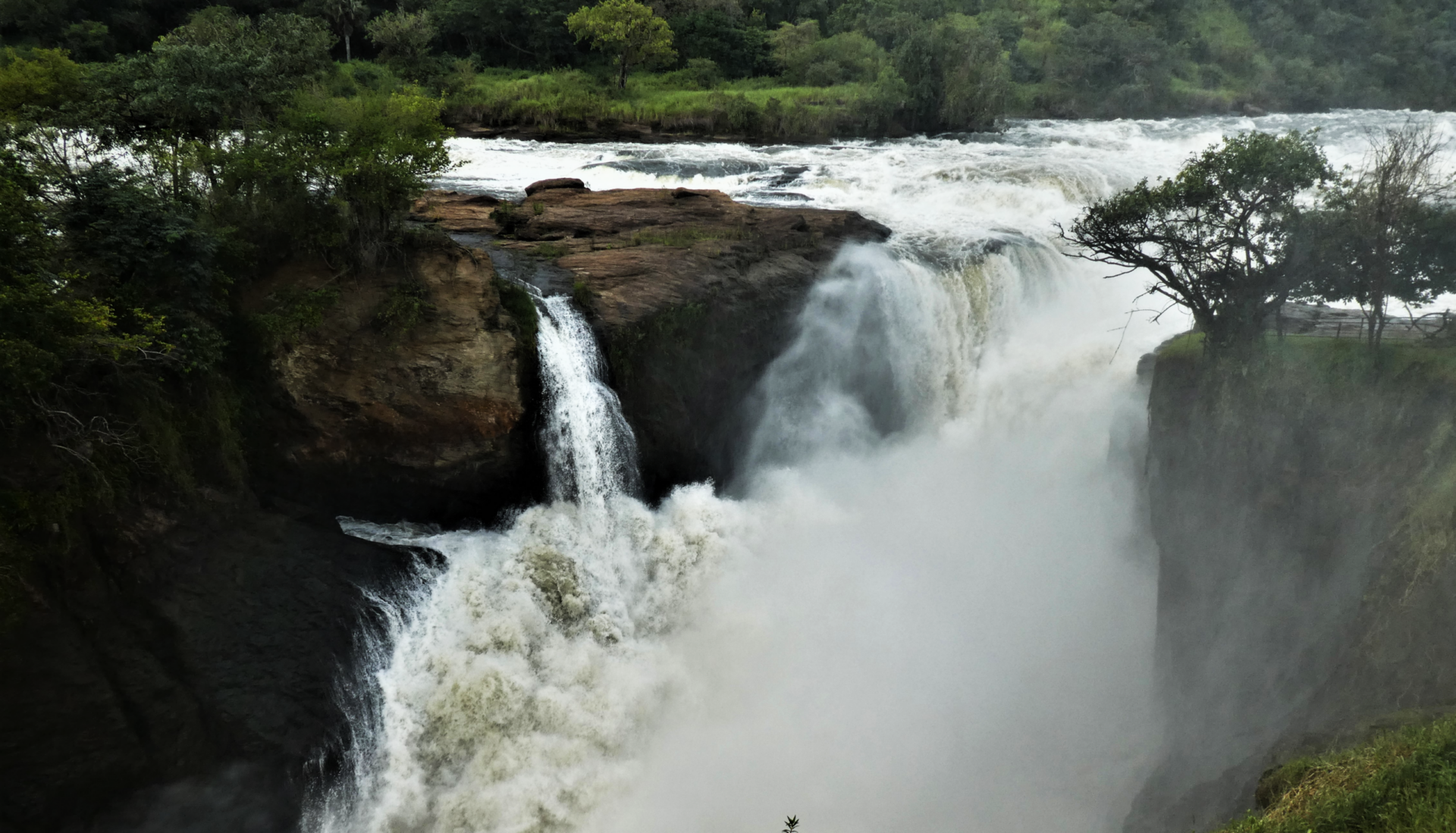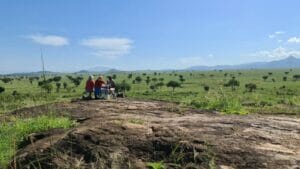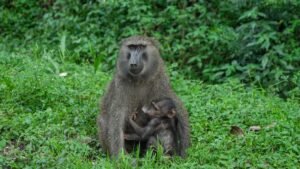Are you ready for an extraordinary journey into the heart of Africa? Imagine yourself venturing deep into dense jungles, surrounded by lush greenery, as you track one of the world’s most magnificent creatures – the gorilla.
Then just days later, you can be traversing vast savannahs, witnessing the Great Wildebeest Migration, and encountering the majestic Big Five in their natural habitat. This is the kind of adventure that awaits you with gorilla trekking and a Tanzania safari.
Both activities are what makes a trip to East Africa such an adventure. With mountain gorillas found in Rwanda, Uganda, and Congo, and Tanzania having some of the best Big Five safari spotting, this is shaping up to be the trip of a lifetime.
As Kikooko Africa Safaris, a locally owned and operated safari company based in Uganda, it’s our pleasure to introduce you to both and to give you more details to help you start planning.
- Combining Gorilla Trekking and Tanzania Safari
- Tanzania Safari
- Why is Gorilla Trekking a Popular Adventure Activity?
- Gorilla Trekking Locations in East Africa
- Planning a Gorilla Trekking Trip
- Tanzania Safari: Exploring the Wildlife
- The Great Wildebeest Migration
- National Parks and Game Reserves in Tanzania
- Tips and Tricks for a Successful Gorilla Trekking and Tanzania Safari Experience
- Book Your Gorilla Trekking and Tanzania Safari Adventure With Kikooko Africa Safaris
Combining Gorilla Trekking and Tanzania Safari
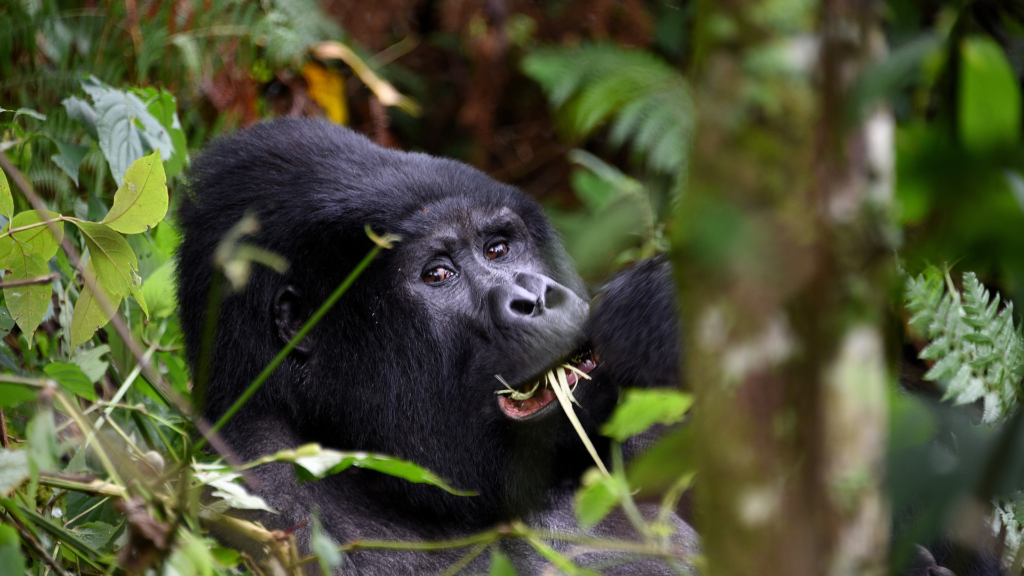
Gorilla trekking and a Tanzania safari are two incredible adventures that offer unique and unforgettable experiences in the heart of Africa. In this section, we will provide an overview of what to expect from both activities and why they have become must-do experiences for travelers seeking a deeper connection with nature and wildlife.
Gorilla trekking is a thrilling and immersive activity that allows you to come face-to-face with these magnificent primates in their natural habitat. The experience begins with a trek through dense forests, guided by experienced trackers who are familiar with the gorillas’ movements and behaviors. As you venture deeper into the wilderness, the anticipation builds, and the chance of encountering a gorilla family becomes more real.
Once the gorillas are located, you will have a precious hour to observe and interact with them. This intimate encounter provides a rare opportunity to witness their social dynamics, observe their behaviors, and marvel at their sheer size and strength. The experience is awe-inspiring and humbling, leaving a lasting impression on all who have the privilege of witnessing these gentle giants up close.
Beyond the sheer excitement of seeing gorillas in their natural habitat, gorilla trekking also offers a deeper understanding of the importance of conservation. By participating in this activity, you directly contribute to the protection of these endangered species and support local communities who rely on sustainable tourism for their livelihoods.
Tanzania Safari
A Tanzania safari takes you on a journey through some of Africa’s most iconic landscapes and wildlife-rich destinations. It is a chance to witness the raw beauty of nature and immerse yourself in the incredible biodiversity that Tanzania has to offer. From vast savannahs to lush wetlands and breathtaking mountains, Tanzania’s diverse ecosystems provide a home to a staggering array of wildlife.
One of the highlights of a Tanzania safari is witnessing the Great Wildebeest Migration, often considered one of the most remarkable natural spectacles on Earth. Millions of wildebeest, accompanied by zebras and other herbivores, traverse the Serengeti ecosystem in search of fresh grazing lands. The sight of thousands of animals on the move is a wildlife spectacle like no other, and it is a testament to the incredible resilience and adaptation of these creatures.
In addition to the migration, Tanzania is renowned for its remarkable national parks and game reserves. The Ngorongoro Conservation Area is a UNESCO World Heritage Site and is home to the Ngorongoro Crater, a haven for wildlife, including the densest population of lions in Africa. The Serengeti National Park, with its sweeping plains and abundant wildlife, offers endless opportunities for game drives and wildlife encounters. Other destinations like Tarangire National Park, Lake Manyara National Park, and Selous Game Reserve also showcase the incredible diversity of Tanzania’s wildlife.
A Tanzania safari is not just about seeing the famous Big Five (lion, leopard, elephant, buffalo, and rhino); it is about immersing yourself in the interconnected web of life that exists in these protected areas. From the graceful giraffes and the playful zebras to the stealthy cheetahs and the mighty elephants, every encounter with wildlife is a privilege that leaves a profound impact on your soul.
Why is Gorilla Trekking a Popular Adventure Activity?
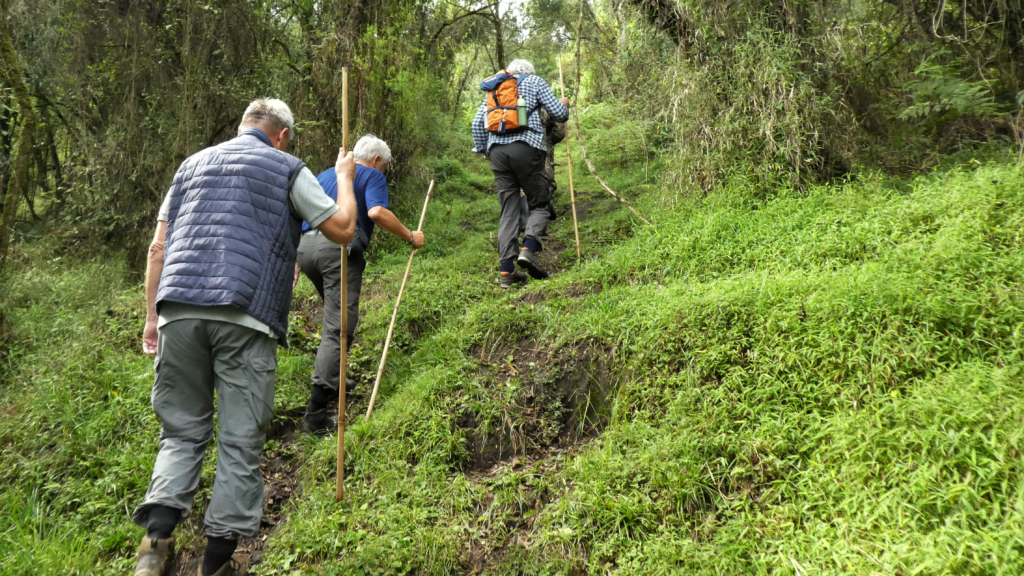
Gorilla trekking has gained immense popularity among adventure seekers and wildlife enthusiasts for several reasons. First and foremost, it offers a rare opportunity to come face to face with an endangered species and witness their natural behaviors. The close proximity to these gentle creatures creates a deep sense of connection and empathy, fostering a greater understanding of the importance of conservation efforts.
Moreover, gorilla trekking allows you to immerse yourself in the remarkable beauty of the African wilderness. The trek itself is an adventure, as you navigate through thick forests, cross streams, and follow the guidance of experienced trackers. The anticipation and excitement of encountering gorillas in their natural habitat add an element of thrill to the experience.
Additionally, the revenue generated from gorilla trekking permits directly contributes to the conservation of these endangered species and supports local communities. By participating in this activity, you play a vital role in ensuring the survival of mountain gorillas and the preservation of their fragile ecosystems.
In the next section, we will delve deeper into the importance of gorilla conservation and the efforts being made to protect these incredible creatures. We will explore the challenges they face and the positive impact that gorilla trekking has on their conservation. So, continue reading to learn more about the significance of preserving these gentle giants and the role you can play in their protection.
Gorilla Trekking Locations in East Africa
East Africa is blessed with remarkable destinations that offer the opportunity to embark on a gorilla trekking adventure. In this section, we will explore the top locations for gorilla trekking in East Africa, highlighting their unique features and what you can expect during your visit.
Bwindi Impenetrable National Park, Uganda
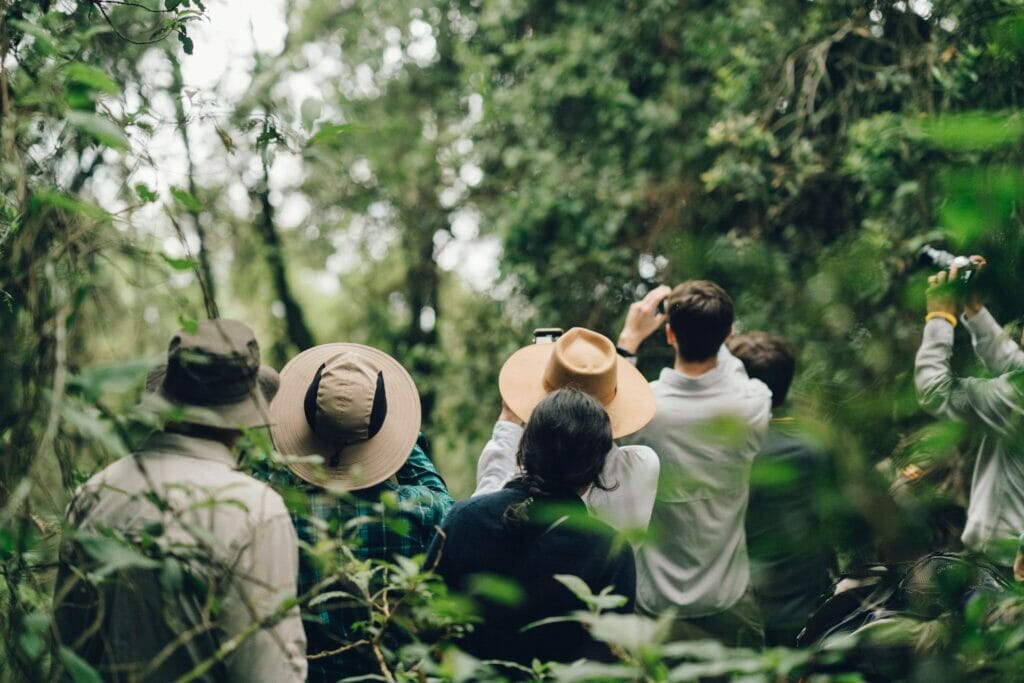
Bwindi Impenetrable National Park, located in southwestern Uganda, is a haven for mountain gorillas. This UNESCO World Heritage Site is home to approximately half of the world’s remaining population of these incredible creatures. The park’s dense forest, mist-covered hills, and rugged terrain create a truly captivating setting for gorilla trekking.
Trekking through Bwindi Impenetrable National Park is an adventure in itself. As you navigate the thick vegetation, guided by experienced trackers, you are enveloped by the sights and sounds of the ancient forest. The trek can be physically demanding, as the terrain can be steep and challenging, but the reward of encountering gorillas in their natural habitat is unparalleled.
The park is divided into several sectors, each with its own gorilla families. The sectors include Buhoma, Ruhija, Rushaga, and Nkuringo. Each sector offers a distinct trekking experience, with different landscapes and gorilla groups to encounter. The encounters with these gentle giants are intimate and awe-inspiring, as you witness their social interactions, grooming rituals, and playful behavior.
Volcanoes National Park, Rwanda
Volcanoes National Park, located in the Virunga Mountains in Rwanda, is another prime destination for gorilla trekking. This iconic park gained international recognition through the groundbreaking conservation work of Dian Fossey, who dedicated her life to studying and protecting mountain gorillas in this area.
The treks in Volcanoes National Park take you through lush bamboo forests and up the slopes of majestic volcanoes. The park offers a range of trekking options, from relatively easy hikes to more challenging routes, catering to different fitness levels and preferences. Along the way, you may encounter other wildlife species, such as golden monkeys, which add an extra element of excitement to the experience.
The encounters with gorilla families in Volcanoes National Park are truly magical. You may witness silverbacks displaying their dominance, mothers nurturing their infants, or juveniles playfully tumbling through the vegetation. The gorillas are accustomed to human presence, which allows for a remarkable closeness that leaves a profound impact on visitors.
Virunga National Park, Democratic Republic of Congo
Virunga National Park, located in the Democratic Republic of Congo, is Africa’s oldest national park and a UNESCO World Heritage Site. This vast and biodiverse park is not only home to mountain gorillas but also boasts an array of other rare wildlife species, including the endangered eastern lowland gorillas.
Gorilla trekking in Virunga National Park is an adventure like no other. The park’s rugged terrain, dense vegetation, and volcanic landscapes create a dramatic backdrop for your trekking expedition. The treks can be physically demanding, as you navigate through challenging terrain, but the effort is well worth it for the incredible encounters that await you.
The encounters with gorillas in Virunga National Park offer a unique glimpse into the lives of both mountain gorillas and eastern lowland gorillas. These gentle creatures thrive in their natural habitat, and the sightings often involve observing their behaviors, social dynamics, and interactions with other wildlife.
Mgahinga Gorilla National Park, Uganda
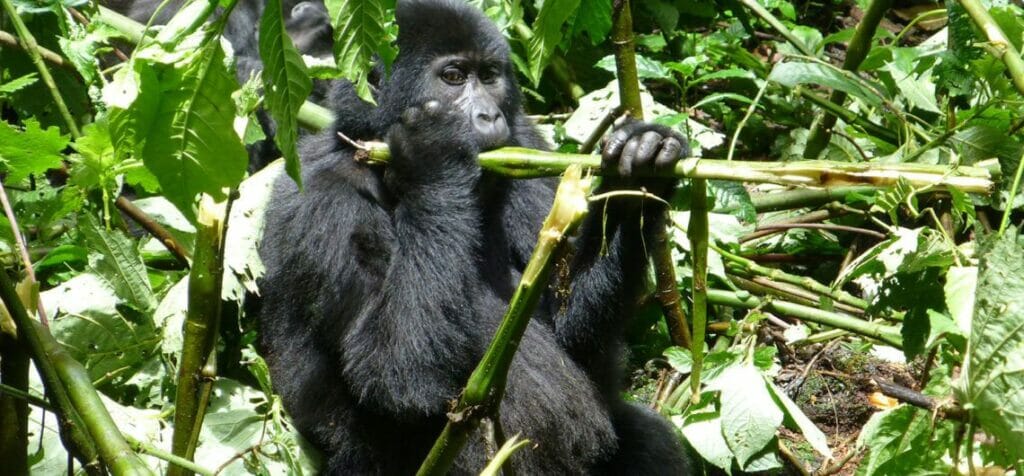
Mgahinga Gorilla National Park, located in southwestern Uganda, is a hidden gem for gorilla trekking. Nestled within the Virunga Mountains, the park is part of the larger Virunga Conservation Area and shares its borders with Rwanda and the Democratic Republic of Congo. The park’s stunning landscapes, comprising bamboo forests, moorlands, and rugged peaks, make it an ideal destination for an immersive gorilla trekking experience.
Trekking in Mgahinga Gorilla National Park offers a sense of adventure and tranquility. The park’s smaller size compared to other gorilla trekking destinations allows for a more intimate and secluded experience. The treks often involve traversing picturesque landscapes while following the movements of the gorilla families.
Encountering the gorillas in Mgahinga Gorilla National Park is a humbling experience. The park is home to one habituated gorilla family known as the Nyakagezi group. Observing these incredible creatures in their natural habitat while surrounded by the stunning scenery of the Virunga Mountains creates a profound connection with nature.
In the next section, we will explore the practical aspects of planning a gorilla trekking trip, including the best time to go, permit information, and essential items to pack. So, continue reading to ensure you are well-prepared for this remarkable adventure.
Planning a Gorilla Trekking Trip
Embarking on a gorilla trekking trip requires careful planning and preparation to ensure a successful and enjoyable experience. In this section, we will delve into the essential factors to consider when planning your gorilla trekking adventure, including the best time to go, permit requirements, fitness and health considerations, and what to pack for your trek.
Best Time to Go Gorilla Trekking
Choosing the right time to go gorilla trekking is crucial for maximizing your chances of encountering these incredible creatures and ensuring favorable trekking conditions. While gorilla trekking is possible year-round, there are a few factors to consider when deciding on the best time for your trip.
The dry seasons, which typically occur from December to February and June to September, are considered the optimal times for gorilla trekking. During these periods, the weather is generally drier, making the trails more accessible and the trekking experience more comfortable. The dry season also coincides with the peak tourist season, so it is advisable to book your permits and accommodations well in advance.
The wet seasons, which occur from March to May and October to November, bring rain and can make trekking more challenging. However, these seasons also offer their own unique advantages. The landscapes are lush and vibrant, and the gorillas are often found at lower altitudes, making them more accessible. Additionally, the wet season is considered the low season, meaning that permits and accommodations may be more readily available.
Ultimately, the best time to go gorilla trekking depends on your preferences and priorities. Consider the weather, your tolerance for rain and humidity, and the availability of permits and accommodations when planning your trip.
Permits and Regulations
Gorilla trekking permits are essential and must be obtained in advance to secure your spot for the trek. The number of permits available per day is limited to minimize the impact on the gorillas and their habitats, so it is crucial to book your permits well ahead of time.
The cost of gorilla trekking permits varies among destinations. Rwanda generally has higher permit fees compared to Uganda and the Democratic Republic of Congo. These fees contribute to conservation efforts and the protection of the gorillas. It is important to note that permit fees are non-refundable, so it is essential to plan your trip carefully and be prepared to commit to your chosen date.
For up-to-date information on mountain gorilla permits, please review our article here.
Gorilla trekking is strictly regulated to ensure the well-being of the gorillas and the safety of visitors. Each trek is led by experienced guides and trackers who are familiar with the gorilla families and their behaviors. It is important to follow their instructions and adhere to the guidelines provided to minimize any potential impact on the gorillas and their habitats.
Fitness and Health Requirements
Gorilla trekking involves hiking through challenging terrains, including steep slopes, dense forests, and potentially muddy trails. It is essential to assess your fitness level and be prepared for the physical demands of the trek. Regular exercise leading up to your trip, including cardio and strength training, can help build stamina and ensure you are ready for the adventure.
Additionally, gorillas are susceptible to human illnesses, and it is crucial to minimize the risk of disease transmission. Before embarking on your gorilla trekking adventure, it is advisable to ensure you are in good health and free from any contagious illnesses. If you have any respiratory or gastrointestinal conditions, it is essential to consult with your healthcare provider before participating in gorilla trekking.
What to Pack for a Gorilla Trekking Adventure
Packing the right gear and essentials is vital for a comfortable and enjoyable gorilla trekking experience. Here are some of the items you should consider packing:
- Sturdy hiking boots: Choose comfortable, waterproof hiking boots with good ankle support to navigate the uneven and muddy terrain.
- Lightweight and breathable clothing: Opt for moisture-wicking and quick-drying clothing, including long-sleeved shirts and pants to protect against nettles, insects, and thorny vegetation. Layering is key to accommodate changing weather conditions.
- Rain gear: Pack a lightweight, waterproof jacket and pants to protect yourself from rain showers and possible muddy trails.
- Daypack: Carry a small backpack to hold essentials such as water, snacks, sunscreen, insect repellent, a camera, and binoculars.
- Drinking water and snacks: Staying hydrated and energized during the trek is crucial, so carry enough water and nutritious snacks to keep you fueled.
- Hat and sunscreen: Protect yourself from the sun’s rays with a wide-brimmed hat and apply sunscreen to exposed skin.
- Insect repellent: Use a reliable insect repellent to ward off mosquitoes and other insects.
- Gloves and gaiters: Consider wearing lightweight gloves and gaiters to protect your hands and lower legs from thorny vegetation and insects.
- Camera and binoculars: Capture the incredible moments and bring binoculars to enhance your wildlife viewing experience.
- Portable charger: Ensure you can keep your electronic devices charged to capture photos and videos of your gorilla encounters.
Remember to pack light and only bring what is necessary for the trek. Porters are often available to help carry your backpack, but it is important to support local communities by bargaining fairly for their services.
In the next section, we will explore the incredible wildlife encounters and the wonders of a Tanzania safari. We will delve into the renowned national parks and game reserves of Tanzania, highlighting the diverse array of wildlife species you can expect to see. So, continue reading to discover the magic that awaits you on a Tanzania safari.
Tanzania Safari: Exploring the Wildlife
A Tanzania safari is a dream come true for wildlife enthusiasts and nature lovers. Tanzania’s diverse ecosystems and protected areas are home to an incredible array of wildlife species, making it one of the top safari destinations in Africa. In this section, we will delve into the renowned national parks and game reserves of Tanzania, highlighting the iconic wildlife encounters and the wonders that await you on a Tanzania safari.
The Great Wildebeest Migration
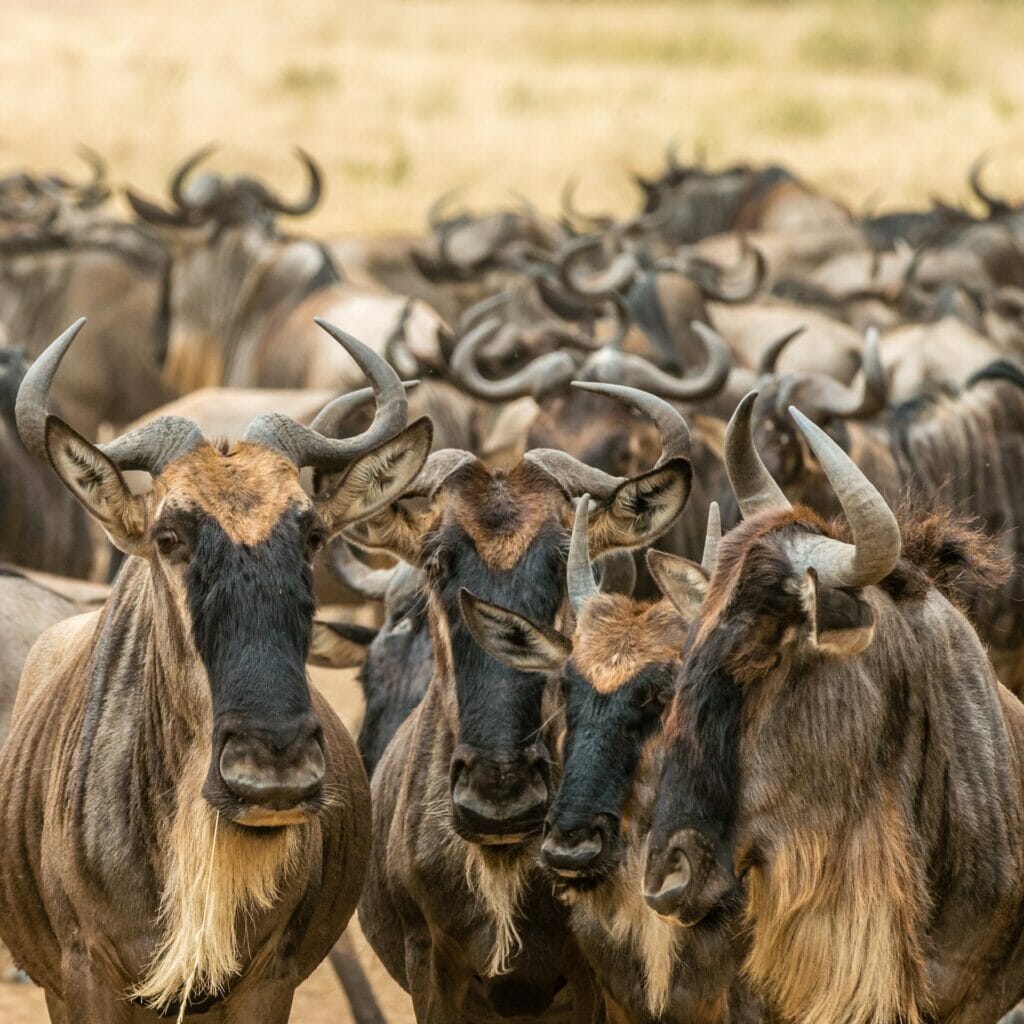
One of the most awe-inspiring natural spectacles on Earth, the Great Wildebeest Migration, takes place in Tanzania’s Serengeti National Park. This annual migration involves millions of wildebeest, accompanied by zebras and other herbivores, as they move in search of fresh grazing lands. The migration is a perpetual cycle that spans the Serengeti ecosystem, with the wildebeest journeying from the southern Serengeti to the Maasai Mara Reserve in Kenya and back again.
Witnessing the Great Wildebeest Migration is an experience that is both humbling and exhilarating. The sight of thousands of animals on the move, braving treacherous river crossings and facing the constant threat of predators, is a testament to the resilience and adaptability of these creatures. It is nature’s grand symphony, where the drama unfolds before your eyes, leaving an indelible mark on your soul.
National Parks and Game Reserves in Tanzania
Tanzania is home to a diverse range of national parks and game reserves, each offering unique landscapes and wildlife encounters. Here are some of the renowned destinations to explore on your Tanzania safari:
Serengeti National Park
The Serengeti National Park is undoubtedly the crown jewel of Tanzania’s safari destinations. Spanning over 14,750 square kilometers, this iconic park is synonymous with the African savannah and is famous for its abundant wildlife. The Serengeti is not only home to the Great Wildebeest Migration but also boasts a resident population of predators, including lions, leopards, cheetahs, and hyenas. The vast plains, acacia woodlands, and rocky outcrops provide a stunning backdrop for game drives and wildlife viewing.
Ngorongoro Conservation Area
The Ngorongoro Conservation Area is a UNESCO World Heritage Site and is home to the Ngorongoro Crater, a natural wonder that boasts one of the highest concentrations of wildlife in Africa. The crater, formed by the collapse of an ancient volcano, is a haven for diverse wildlife, including elephants, buffalos, zebras, and an impressive population of lions. The dramatic landscapes of the crater, with its lush grasslands and soda lakes, create a unique and breathtaking setting for wildlife encounters.
Tarangire National Park
Tarangire National Park is known for its remarkable elephant population and stunning baobab trees. The park’s diverse habitats, including riverine forests, savannahs, and swamps, attract a wide range of wildlife species. During the dry season, Tarangire becomes a haven for wildlife as animals congregate around the Tarangire River, creating incredible opportunities for game viewing. Alongside elephants, visitors can spot lions, leopards, giraffes, zebras, and an abundance of bird species.
Lake Manyara National Park
Lake Manyara National Park is a hidden gem nestled at the base of the Great Rift Valley escarpment. The park’s star attraction is the alkaline Lake Manyara, which provides a habitat for a vast array of bird species, including flamingos and pelicans. The park’s diverse landscapes encompass a mix of forests, grassy plains, and woodland, creating a haven for wildlife such as elephants, zebras, giraffes, and tree-climbing lions. A game drive through Lake Manyara National Park offers a unique and picturesque safari experience.
Selous Game Reserve
The Selous Game Reserve is one of Africa’s largest protected areas, spanning over 50,000 square kilometers. This pristine wilderness is renowned for its untouched landscapes, including savannahs, woodlands, and rivers. The reserve is home to a myriad of wildlife, including elephants, lions, leopards, hippos, and crocodiles. The Selous offers a more remote and off-the-beaten-path safari experience, with fewer crowds and a sense of exclusivity.
These are just a few of the remarkable national parks and game reserves that await you on a Tanzania safari. Each destination offers its own unique charm and wildlife encounters, ensuring an unforgettable adventure in the heart of Africa’s wilderness.
Tips and Tricks for a Successful Gorilla Trekking and Tanzania Safari Experience
Embarking on a gorilla trekking and Tanzania safari adventure is a thrilling and once-in-a-lifetime experience. To ensure a successful and memorable trip, there are several tips and tricks to keep in mind. In this section, we will provide you with valuable insights and practical advice to enhance your journey and make the most of your time in East Africa.
Etiquette and Guidelines during Gorilla Trekking
When participating in gorilla trekking, it is crucial to adhere to certain etiquette and guidelines to ensure the well-being of the gorillas and the safety of both visitors and the animals. Here are some key considerations:
- Maintain a safe distance: Keep a minimum distance of 7 meters between yourself and the gorillas. This helps minimize the potential transmission of diseases and ensures the gorillas’ comfort.
- Follow the guide’s instructions: Listen carefully to your guide’s instructions and follow their lead during the trek. They are experienced in gorilla behavior and will ensure a safe and respectful encounter.
- Avoid direct eye contact: While it is natural to be fascinated by the gorillas, avoid direct eye contact, as this can be perceived as a threat. Instead, maintain a relaxed posture and observe them with a sense of awe and respect.
- Do not touch the gorillas: Although the gorillas may come close to you out of curiosity, resist the urge to touch them. This helps maintain their wild behavior and prevents potential harm to both you and the gorillas.
- Keep noise to a minimum: Speak softly and avoid making sudden loud noises during the encounter. This helps maintain a calm and peaceful atmosphere, ensuring a more natural experience for the gorillas.
- Do not feed the gorillas: Feeding the gorillas is strictly prohibited. Their diet consists of natural vegetation, and human food can be harmful to their health.
By following these guidelines, you contribute to the well-being of the gorillas and help preserve their natural behaviors.
Safety Considerations during a Tanzania Safari
While a Tanzania safari is a thrilling adventure, it is essential to prioritize safety and take precautions to ensure a smooth and enjoyable experience. Here are some safety considerations to keep in mind:
- Follow the instructions of your safari guide: Your safari guide is experienced and knowledgeable about the wildlife and the park regulations. Listen to their advice and follow their instructions to ensure your safety and the safety of the wildlife.
- Stay inside the vehicle: While on a game drive, it is important to remain inside the safari vehicle unless instructed otherwise by your guide. This minimizes potential risks and ensures your safety while observing wildlife.
- Respect the animals’ space: While wildlife encounters can be exhilarating, it is crucial to maintain a safe distance and avoid approaching animals too closely. This ensures the animals’ comfort and reduces the risk of accidents.
- Be cautious during walking safaris: If you participate in walking safaris or guided nature walks, pay attention to your guide’s instructions and stay together as a group. Avoid straying away or approaching potentially dangerous wildlife without proper guidance.
- Protect yourself from insects and the sun: Use insect repellent to protect yourself from mosquitoes and other insects. Additionally, apply sunscreen and wear protective clothing, such as hats and long sleeves, to guard against the sun’s rays.
- Stay hydrated and carry essentials: Drink plenty of water to stay hydrated, especially in the African heat. Carry essential items such as a hat, sunglasses, a first aid kit, and any necessary medications.
By prioritizing safety and following the guidance of your safari guide, you can enjoy your Tanzania safari with peace of mind.
Cultural Interactions and Community Engagement
In addition to the wildlife encounters, a Tanzania safari provides opportunities for cultural interactions and community engagement. Embrace these experiences to gain a deeper understanding of the local cultures and support sustainable tourism practices. Here are some ways to engage with local communities:
- Visit local villages: Arrange visits to local villages to learn about the traditional way of life and interact with community members. This provides insights into their customs, traditions, and daily activities.
- Support local initiatives: Seek out community-based tourism initiatives that empower local communities and contribute to their socio-economic development. This can include purchasing locally made crafts or participating in activities that directly benefit the community.
- Respect local customs and traditions: Familiarize yourself with the cultural norms and customs of the communities you visit. Respect their traditions and practices, and be mindful of appropriate behavior in different cultural contexts.
- Participate in responsible tourism practices: Choose tour operators and accommodations that prioritize responsible tourism practices. These may include initiatives that support conservation efforts, employ local staff, or minimize environmental impact.
Engaging with local communities adds depth and meaning to your Tanzania safari, allowing you to connect with the people and cultures that make this region so vibrant.
Enhancing Your Safari Experience
To truly make the most of your gorilla trekking and Tanzania safari adventure, consider enhancing your experience with specialized activities and unique opportunities. Here are a few options to consider:
- Night game drives and walking safaris: Some national parks and reserves offer night game drives and walking safaris, allowing you to witness the nocturnal activities of wildlife or explore the wilderness on foot. These experiences offer a different perspective and a chance to encounter wildlife in a more intimate setting.
- Hot air balloon safaris and scenic flights: Take to the skies and soar above the landscapes on a hot air balloon safari or a scenic flight. This provides a bird’s-eye view of the vast plains, majestic mountains, and winding rivers, offering a breathtaking perspective of Tanzania’s natural beauty.
- Specialized safari experiences: Consider tailor-made safari experiences focused on specific interests, such as photography safaris, birding safaris, or conservation-focused safaris. These specialized trips allow you to delve deeper into your passion and connect with like-minded individuals.
By adding these unique experiences to your itinerary, you can create unforgettable memories and gain a deeper appreciation for the natural wonders of East Africa.
In the next section, we will conclude our exploration of gorilla trekking and Tanzania safari, summarizing the highlights of this ultimate adventure and offering final recommendations for a memorable experience. So, keep reading to complete your journey through the enchanting world of East Africa’s wildlife and wilderness.
Book Your Gorilla Trekking and Tanzania Safari Adventure With Kikooko Africa Safaris
Gorilla trekking takes you on a captivating journey into the world of mountain gorillas, granting you the privilege of observing and interacting with these majestic creatures in their natural habitat. The trek through dense forests, guided by experienced trackers, builds anticipation and excitement as you venture deeper into the wilderness. The encounter with gorilla families is an awe-inspiring experience, leaving an indelible mark on your soul. It is a chance to witness their social dynamics, learn about their behaviors, and gain a profound appreciation for their conservation.
Pairing gorilla trekking with a Tanzania safari allows you to further explore the remarkable biodiversity of East Africa. Tanzania’s national parks and game reserves offer a wealth of wildlife encounters, from the iconic Big Five to a myriad of other species that call these protected areas home. The Great Wildebeest Migration in the Serengeti is a spectacle unlike any other, showcasing the resilience and wonder of nature.
Engaging with local communities and supporting responsible tourism practices adds depth to your adventure, allowing you to connect with the people and cultures that make this region so vibrant. Learning about traditional customs, supporting local initiatives, and respecting cultural traditions enriches your experience and fosters a sense of mutual understanding and appreciation.
To learn more, feel free to get in touch with the team at Kikooko Africa Safaris today.
